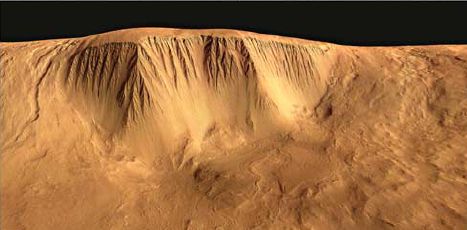Mars Volcanoes Possibly Still Active, Pictures Show

Images from a European space probe reveal recent glacial deposits and lava flows on Mars that suggest the red planet is more active than many scientists had thought.
The European Space Agency's Mars Express orbiter photographed lava flows that must have occurred within the past two million years and imply, scientists say, that volcanoes on Mars might still pump molten rock to the surface now and then.
And on the flanks of Olympus Mons, the largest volcano on Mars, pictures reveal material left by glaciers that were active within the past four million years or so. The gargantuan volcano -- taller than any in the entire solar system -- may still harbor dust-covered snow and ice at its higher altitudes, researchers conclude.
Age spots
Estimating the age various surface layers on Mars is tricky business. But the new high-resolution, stereo images provide a detailed view not available before. Mars Express sent back its first pictures in January 2004.
Here's what scientists looked for:
Mars has been rattled by asteroids throughout its history, and the resulting craters -- some too small to be seen by other spacecraft -- are like age spots on human skin. Regions that are smooth as a baby's bottom must have been "resurfaced" recently, in geologist's parlance.
Breaking space news, the latest updates on rocket launches, skywatching events and more!
The resurfacing can be done by lava, the scraping of glaciers, or even wind erosion. Telltale geologic features reveal the sort of process at work.
Some of the Martian lava fields must have been created very recently in geologic time, because of the very small number of impact craters on them, said study leader Gerhard Neukum of the Free University in Berlin.
But if volcanoes on Mars are still active, as Neukum and his 10 colleagues from institutions in several countries suspect, why has the activity never been spotted?
"Outbreaks happen from time to time over a short period of time," Neukum told SPACE.com. "We would be extremely lucky if it happened while Mars Express is in orbit and we are right over the site where it is happening."

He said the orbiter might get lucky in coming years and "see some action, but the chances are slim."
Evidence of past glacial activity includes features carved into the surface in much the same manner as terrestrial glaciers in Antarctica, along with rocky material transported down slopes. In particular, one high-altitude ridge on Olympus Mons juts more than 1,300 feet (400 meters) above the surrounding terrain. Neukum and his colleagues think it is an ice cap covered by dust.
Other studies have shown that both poles of Mars are packed with water ice, and that ice also persists underground away from the poles.
Similar to Earth
Scientists have long sought to determine how geologically active Mars has been in recent times. A study in 2001 based on images from NASA's Mars Global Surveyor spacecraft hinted at recent volcanic activity.
The new work, reported in the Dec. 23 issue of the journal Nature, involved five volcanoes: Olympus Mons, Ascraeus Mons, Arsia Mons, Albor Tholus and Hecates Tholus.
Each of the mountains is dominated by a caldera, a depression at the top that is the collapsed remains of eruptions past. Multiple episodes of activity -- up to five in some cases -- were found to have occurred in each caldera.
The lava flows are similar to those that roll out of volcanoes in Hawaii, Neukum said.
By determining various ages of different lava flows, the researchers found that some of the volanoces appear to have been active for roughly 80 percent of the 4.5-billion-year history of Mars. Terrestrial volcanoes, by contrast, typically are born and become extinct within a million years.
"The very long activity of Martian volcanoes implies correspondingly long lifetimes of 'hot spots' in the planet's interior," the researchers write in the journal. One challenge now, they say, is to figure out how these hot spots differ within the two planets.
- The Towering Olympus Mons
- Planet Building: Volcanoes No Longer Rule, But They Still Rage

Rob has been producing internet content since the mid-1990s. He was a writer, editor and Director of Site Operations at Space.com starting in 1999. He served as Managing Editor of LiveScience since its launch in 2004. He then oversaw news operations for the Space.com's then-parent company TechMediaNetwork's growing suite of technology, science and business news sites. Prior to joining the company, Rob was an editor at The Star-Ledger in New Jersey. He has a journalism degree from Humboldt State University in California, is an author and also writes for Medium.
